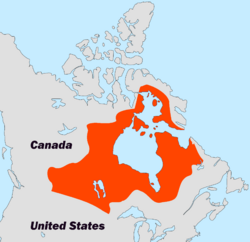Dominion of Rupert's Land
This article refers to a micronation or element of micronationalism which is defunct and no longer exists. You can help make the article reflect that or ask on the talk page for further information. |
Dominion of Rupert's Land | |
|---|---|
|
Flag | |
| Anthem: God Save the King | |
 Claimed territory (red) within North America (grey) | |
| Status | Self-declared Dominion |
| Location | Canada |
| Capital | None official |
| Official languages | English French |
| Recognised regional languages | First Nations languages |
| Religion | Anglicanism Indigenous beliefs |
| Demonym(s) | Rupertslander |
| Government | Unitary parliamentary constitutional monarchy |
• Monarch | Charles III |
• Governor-General | Vacant |
• Prime Minister | Luke Gonyer |
| Legislature | Parliament |
| House of Lords | |
| House of Commons | |
| Foundation | |
• Independence declared | 16 September 2019 |
• Dissolution | 14 September 2022 |
| Area | |
• Total | 3,861,400 km2 (1,490,900 sq mi) |
| Population | |
• 2022 census | 35 |
| Currency | Rupert's Land Pound (£) Canadian dollar ($) |
| Date format | mm/dd/yyyy |
| Driving side | right |
| Calling code | +1 |
| Internet TLD | .ca |
The Dominion of Rupert's Land was a micronation founded by Dustin Williamson in 2019. It nominally claimed the territory of Rupert's Land that was operated by the Hudson's Bay Company in British North America from 1670 to 1870. The area is currently part of Canada.
Its administration sought to change the current status of the territory to that of a self-governing dominion, and be considered for recognition as a new Commonwealth realm. The Dominion of Rupert's Land exercised no physical control over the vast area it claims, nor was its existence acknowledged by the United Nations or the government of any sovereign country. Initially established as somewhat of a "lighthearted joke" according to Williamson, it eventually grew into a more dedicated venture with wider aspirations. The dominion printed its own currency, issues passports and boasted a small but passionate population of Rupertslanders located around the world.
Etymology
Rupert's Land was named after Prince Rupert of the Rhine, a nephew of Charles I and the first Governor of the Hudson's Bay Company. The prefix Dominion was added to differentiate between the former territory and current administration, as well as to reflect the fact that the Dominion of Rupert's Land was an aspiring nation with its own autonomous government.
Politics and government
The Dominion of Rupert's Land was governed as a unitary parliamentary constitutional monarchy.
Law and order
The judicial branch of the dominion consists of the Supreme Court, the Summary Court and the Court of Appeal. The court system was completely independent from the legislative branch of government, and handles all internal legal matters within the country. As a general policy, the Dominion of Rupert's Land required its citizens to obey all Canadian federal, provincial and local laws at all times. The same rule applied to its citizens living abroad with regards to the laws of their home countries.
Geography and climate
The territory claimed by the Dominion of Rupert's Land is enormous, totaling roughly 3,861,400 square kilometers, and is comprised of the majority of the Hudson's Bay drainage basin. Its borders matched those of the final boundaries claimed by historical Rupert's Land, between the signing of the Treaty of 1818 and its incorporation into Canada in 1870. It included the whole of Manitoba, the majority of Saskatchewan, as well as parts of Alberta, Nunavut, Ontario and Quebec, but excluded areas that extended south into parts of Minnesota, North Dakota, and Montana prior to 1818. These claims were purely nominal, since the Rupert's Land government's jurisdiction was limited to its embassies in Winnipeg and Vancouver, as well as its parliament located at Government House.
This article has not been added to any content categories. Please help out by adding categories to it so that it can be listed with similar articles. (July 2023) |
